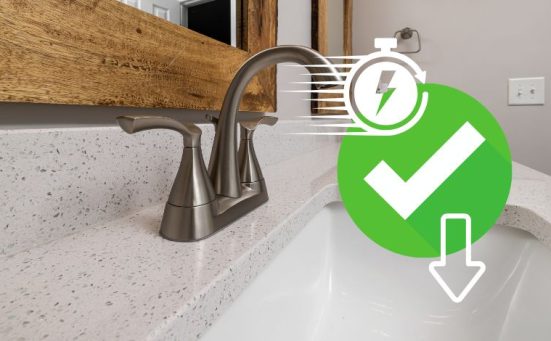
Kitchen Floor Sticky After Mopping? (it’s because of this…)
It can be so annoying and disheartening, you take time out of your busy schedule to mop the kitchen floor and when you’re finished, your feet stick to the floor as you walk. If this is happening to you, keep reading, because we have looked into the reasons behind this phenomenon and our results might just surprise you.
Why Is The Kitchen Floor Sticky After Mopping?
It’s very frustrating to find that once the kitchen floor dries it’s sticky under foot. It can make you wonder why you bothered to spend the time mopping it. Many people even begin to wonder if their kitchen flooring is the problem.
In most cases, the problem is not the kitchen floor, or the technique used when mopping the floor. The actual cause of the floor feeling sticky after mopping can be as simple as any one of the following:
Using The Wrong Cleaning Agent
To clean your kitchen floor correctly, you need to use the right type of floor cleaner. Normal floor cleaning usually only needs a simple soapy water solution or some mild chemicals to clean the floor, some of the dirt stuck to the kitchen floor might need a specific cleaner to remove it.
What that means is that if the floor has some sort of acidic stain it will take an alkaline cleaner to remove it and vice versa. Common dirt found on the average kitchen floor is of the alkaline variety. This means in most cases the floor cleaner needed will be acidic.
Using the correct type of cleaner for the dirt that has accumulated on your kitchen floor will result in cleaner floors that are not sticky under foot.
Using Too Much Cleaning Product
Even if you use the correct cleaning agent on your kitchen floor, using too much can cause the floor to dry sticky. If you use too much cleaner, the floor will look clean, but as it dries that extra cleaner creates a residue which dries sticky. Always follow manufacturers instructions when using any floor cleaner.
Not enough floor cleaner – and the floor won’t clean properly, too much – and the floor can become sticky.
Most floor cleaners use the bottle’s cap as a measuring device, always use the exact amount of cleaner with the amount of water used. This simple act could be the difference between a clean floor and a sticky floor.
Using Dirty Water To Clean The Floor
If you have a large kitchen floor to clean, even if you’re using the correct floor cleaner in the right quantity, You could be spreading dirt around the floor. This is because every time you put your mop into the bucket it is getting covered in whatever is in that bucket. The first few mopfuls of soapy water are going to be fine, but the more dirt you remove, the more dirt is going to be in your bucket.
Keep an eye on the water in the bucket, it will become apparent when it needs replacing with a fresh water and cleaning agent solution. And be sure to rinse the dirty residue away completely before refilling your bucket. This will ensure your kitchen floor is cleaned properly and prevent you from spreading more dirt onto already dirty floors.
Not Rinsing The Floor Correctly

The after wash rinsing is just as important as the actual washing of the floor when it comes to removing anything likely to make the floor sticky. Always ensure the water used to rinse the floor is fresh and clean. This will probably involve rinsing the bucket a few times to remove any residue left behind by the cleaning agent,
Then rinse a small area before changing the rinsing water in the bucket to ensure you are always rinsing with clean water. It will be easy to spot when the water needs changing by the colour of it. The darker it becomes, the dirtier it is.
Faulty Cleaning Equipment
Even using the correct cleaning agent, with the right amount of water can cause sticky floors if the bucket used was dirty or the mop head is old and worn. The mop and bucket should also be washed out completely after each use, and the mop head dried to prevent any bacteria growth.
Not Cleaning The Floor Often Enough
This might sound obvious to you, but any surface which is not cleaned regularly is going to feel sticky, especially in a kitchen. Spilt drinks, oils, fruit juice etc can all just get coated in dirt and other debris and leave your kitchen floor in a right old state. The best way to combat this is with a regular cleaning regime.
Once or twice a week might be enough for your kitchen. Or the floor might need cleaning every day, you’re the only one who can tell how often your kitchen floor needs cleaning. But however often you decide it needs cleaning, make sure you do it as often as needed and stick to your schedule.
How To Prevent Kitchen Floors Becoming Sticky
There are a number of ways you can help prevent your kitchen floor from becoming sticky under foot. Here are a few of them;
- Clean Any Spills Immediately
By removing any spills from the floor as soon as they happen you can prevent them drying into a sticky mess - Remove Surface Dirt Before Mopping
It’s always best practice to remove all of the surface dirt before tackling the floor with a mop. Sweep the floor thoroughly and use a dustpan and brush to remove all of the dirt and detritus before you start mopping the floor. - Always Use The Correct Cleaner
As mentioned above, always use the right cleaner for the type of dirt that is stuck to your kitchen floor. Read the instructions on the bottle and use accordingly. - Keep The Water Clean
Remember to change the water regularly to prevent you from spreading more dirt around your floor as you mop. - Rinse Using Clean Water
Keeping the floor clean starts by ensuring the water you use to rinse it is clean too. This might entail throwing soiled water away and starting again a number of times, depending on how large the area being cleaned is. - Stick To A Regular Cleaning Regime
Be sure to clean your kitchen floor on a regular basis. This might only need to be once a week, but it might be more frequent, only you can tell. - Keep Your Equipment In Good Condition
There’s no point cleaning the floor if the bucket is dirty and the mop is spreading germs and bacteria. Always rinse the bucket before and after use and check that the mop is clean before use. - Consider Investing In New Cleaning Equipment
If your mop is looking old and worn, consider replacing it with a new one. There are also more effective cleaning tools available nowadays, like steam mops which can be great weapons in the fight against sticky floors.
Frequently Asked Questions
There are a few reasons why your kitchen floor is sticky after mopping. These include; using an incorrect cleaner, using too much cleaner, using dirty water, not rinsing correctly or using a dirty mop.
The secret to using a mop without leaving any residue is to always use clean water. This might mean changing the water used for cleaning in the bucket a few times, and refreshing the water used to rinse the floor.
You should mop floors in high traffic areas like kitchens frequently. At least once a week or more if your kitchen is used regularly.
You can mop with just water but this is not an effective way of removing any stains, dirt or bacteria. It is always better to use the correct cleaner when mopping the floor.
Also, follow us on Pinterest ...



